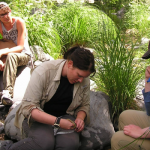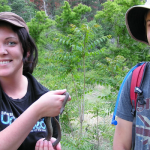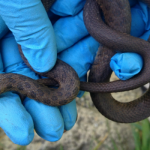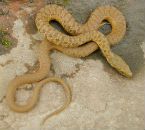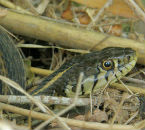Published papers
Our amazing interns
- 2018: Troy Andrea
- 2017: Elizabeth Brambert, Cassidy Klovanish, and Jacque Lyman
- 2016: Kayla Christy, Luke Jarrin, and Michael Morton
- 2015: Meaghan Miller and Melissa Portwood
- 2014: Krystal Anderson, Jackson Bain, Tonya Keno, and Hannah Wilson
- 2013: Kristen Fouts and Cori Wolfe
Field research
We are conducting field research on narrow-headed and northern Mexican gartersnakes across Arizona and New Mexico with our collaborators.
Narrow-headed Gartersnake
Dr. Nowak has worked extensively in Oak Creek, Arizona, starting in 1999 with a status and distribution survey of narrow-headed gartersnakes. During 2004-2005, she conducted a radio-telemetry study of the ecology, activity period, and habitat use of adult narrow-headed gartersnakes in upper Oak Creek Canyon. Beginning in 2001, she initiated annual monitoring surveys in 1-kilometer transects at four locations in Oak Creek Canyon; these monitoring transects were expanded to include three additional sites during 2012-2014. Each transect is surveyed three times per year in an attempt to understand long-term patterns of gartersnake distribution and abundance, as estimated through detection rates of gartersnakes per person-hour of surveying.
Dr. Nowak and members of the NAU gartersnake team assisted with planning, implementing, and monitoring of salvaged narrow-headed gartersnakes threatened by the 2012 Whitewater-Baldy Fire in New Mexico and their introduction into a nearby creek which was not affected by the fire.
We have also surveyed for narrow-headed gartersnakes throughout the Apache-Sitgreaves, Prescott, and Gila National Forests, primarily to assess current distribution and population status, and to determine wildlife effects on gartersnakes. We are currently working with the US Fish and Wildlife Service and other collaborators to determine the prevalence and effects of disease and parasites in wild gartersnake populations.
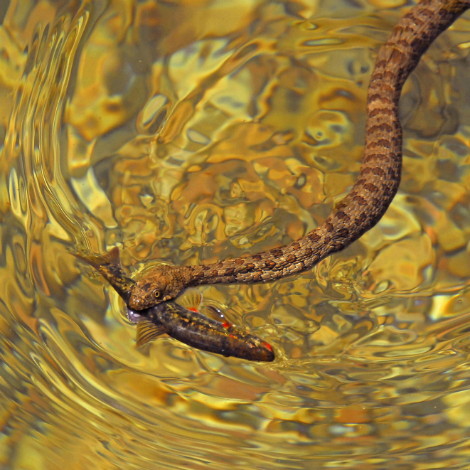 Narrow-headed Gartersnake with prey. (Photo by George Andrejko)
Narrow-headed Gartersnake with prey. (Photo by George Andrejko)
Northern Mexican Gartersnakes
We have surveyed throughout the Prescott National Forest to determine the status and distribution of northern Mexican gartersnakes, and to determine potential gartersnake predator and prey species composition.
NAU and ASU graduate students have conducted radio-telemetry studies of the ecology and habitat use of northern Mexican Gartersnakes in the Verde Valley, Bubbling Ponds Fish Hatchery, and at Lower Tonto Creek, Arizona. These studies include determination of potential gartersnake prey and predators, and also comparisons of summer and winter use by adult snakes. We are also assisting staff at Tuzigoot National Monument with a long-term monitoring program and a radio-telemetry study of the movements and ecology of northern Mexican gartersnakes.
Research on Pathogens of Federally-listed Gartersnakes
By Troy Andrea
For the past 20 years, students and researchers at Northern Arizona University have been studying and monitoring populations of Northern Mexican and Narrow-headed Gartersnakes in the wild throughout the Southwest and in captivity. Additionally, research is being done to detect the possible presence of Ophidiomyces ophiodiicola here in the southwestern U.S., and assist with the development of management strategies that will allow for successful recovery of both gartersnake species.
Ophidiomyces ophiodiicola is a contagious and rapidly spreading fungus that has only been found in snake populations . It was originally reported in wild populations of snakes in Europe in the 1980’s, but after phylogenetic testing of the fungus, it was determined that a new clade had reached New Hampshire in 2006, affecting a population of pit vipers. A 2006 study of Timber rattlesnakes (Crotalus horridus) in New Hampshire revealed a sharp decline in population, thought to be partially due to a fungal infection correlated with an abnormally wet May through October. Today, the disease has been documented in 23 states as well as in one Canadian province. Although there has not been a confirmed case of Snake Fungal Disease (SFD) in Arizona or New Mexico, minute traces of O. ophiodiicola DNA were detected in a deceased captive Narrow-headed Gartersnake at NAU.
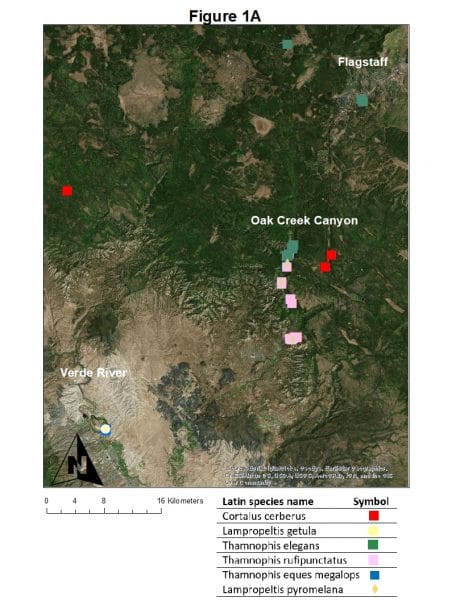
We use visual encounter surveys (VES) and sometimes Gee Exotic fish trap transects to detect Narrow-headed and Northern Mexican gartersnakes in the wild. In addition to weighing, measuring, and individually marking snakes, we record the animals’ physical states and any signs of possible infections, and have collected skin swab samples for SFD and mites and, (Figure 1A and 1B). We also actively monitor and sample our captive population for mites and evidence of SFD infection and O. ophiodiicola presence. We are working with NAU and external collaborators to screen these samples. In doing so, we hope to increase understanding of O. ophiodiicola distribution, and be better prepared to recover and manage snake populations if this disease is found to be contributing to the decline of Gartersnake populations in northern Arizona and the surrounding regions.
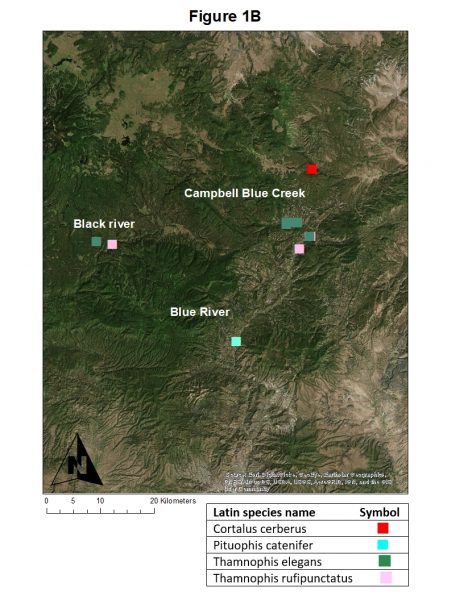
As of April 2019, the NAU vivarium houses four of the original 11 Narrow-headed Gartersnakes that were relocated from Oak Creek. Two females produced three litters totaling 32 offspring in 2017 and 2018. These juveniles are used as research animals, helping us to understand the needs of both captive and wild Narrow-headed Gartersnakes, and improve our husbandry program accordingly. They will not be re-released into the wild until extensive sampling has been done to determine if they may be infected by the presence or prevalence of O. ophiodiicola, and a post-release monitoring plan has been approved.
Understanding the fungus’s effects on snakes, as well as its possible abundance and distribution in the western US, is crucial to the survival of federally-threatened Gartersnakes and other native snake species. Anthropogenic activities like increasing infrastructure, transportation and recreation are resulting in habitat loss and fragmentation, making these snake populations more susceptible to stochastic events and disease. Unchecked, this disease could easily infect fragmented populations. With additional research support and collaboration, we hope to be able to better understand SFD, and be able to assist local and federal managers in protecting and recovering the threatened northern Mexican and Narrow-headed Gartersnake populations.
___________________________________________
